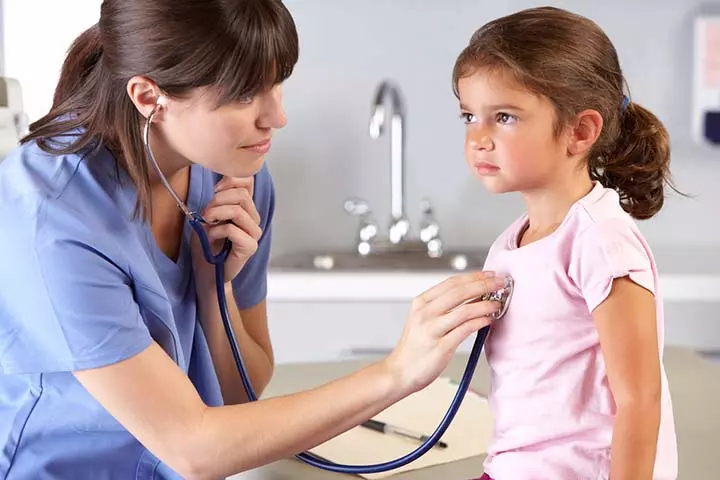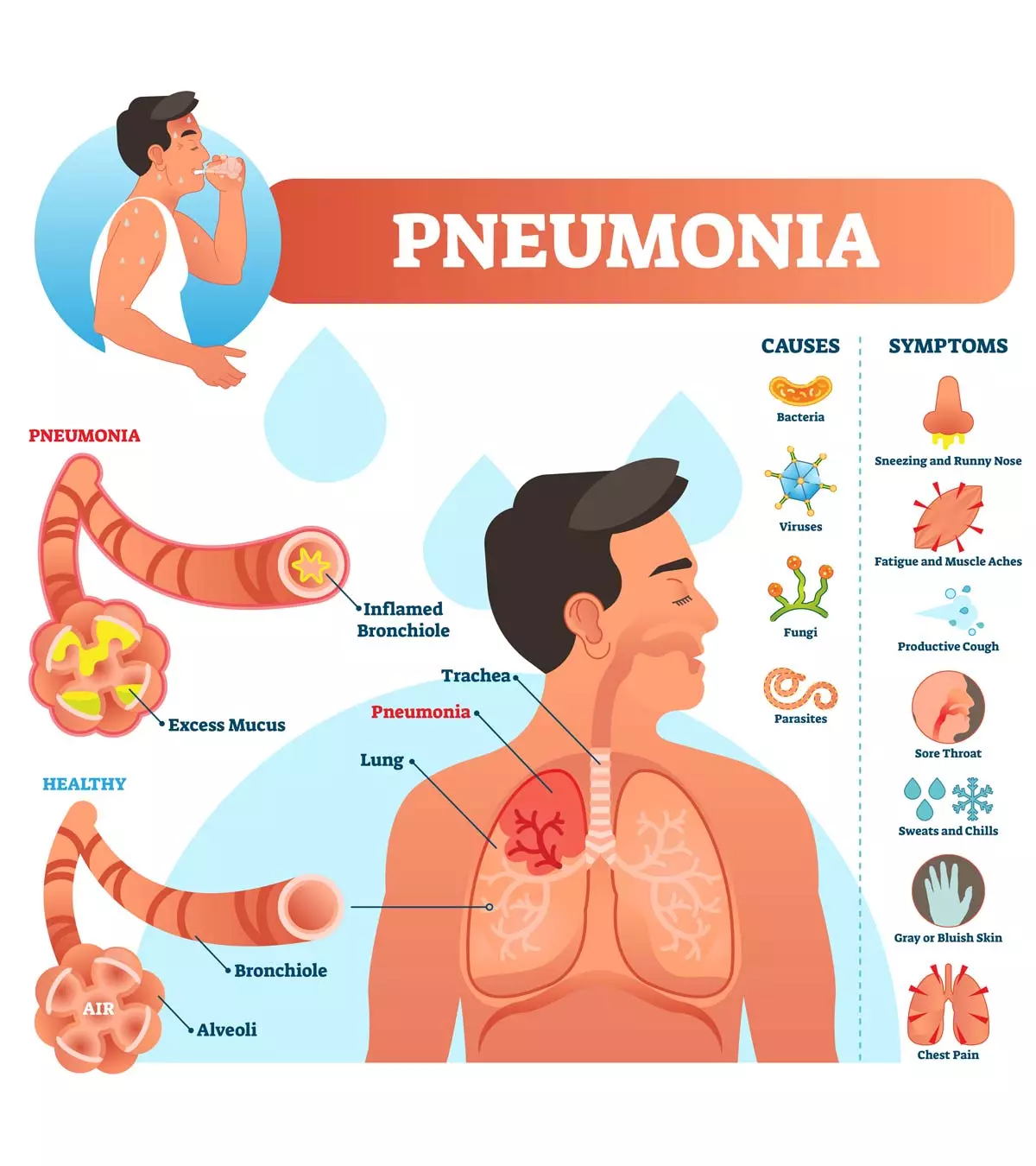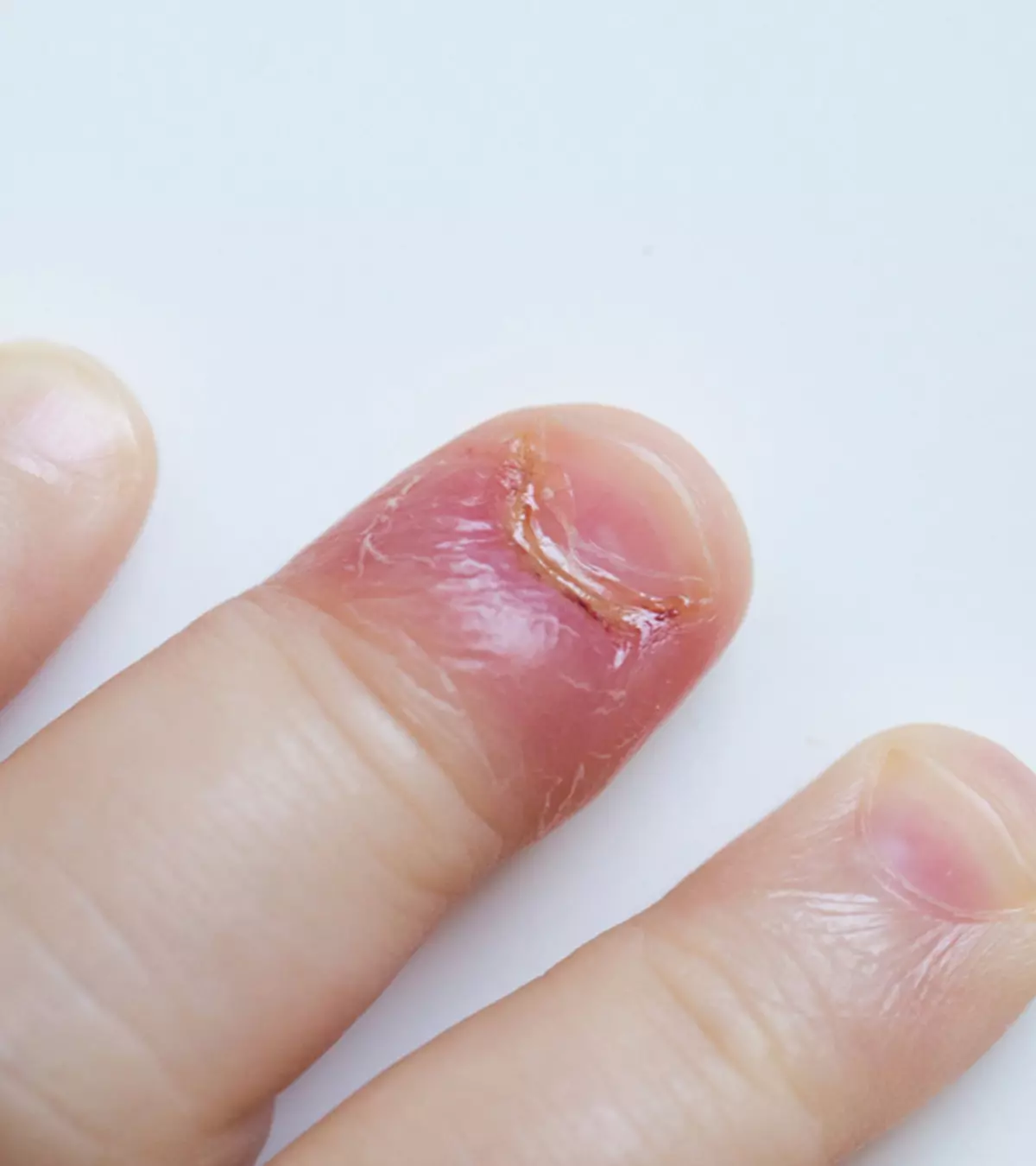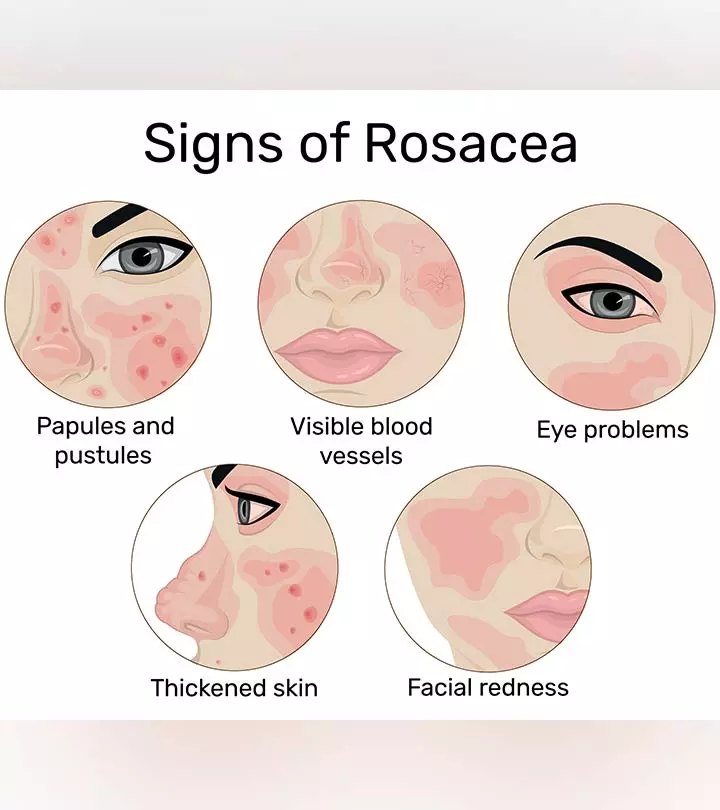
Image: Shutterstock

Tics in children usually begin from 3-9 years of age and become more severe from 9-11 years of age. Childhood tics are more common in boys than in girls (1). Tics are quick and difficult-to-control body jolts or sounds caused by fast, repetitive muscle movements or vocalizations. Most people may regard it as an unavoidable submission to an almost irresistible impulse, even though it is occasionally defined as involuntary (2) (3). At least one tic affects about a quarter of all children at some point during childhood (4).
Learn about the different types of tics, their causes, symptoms, and treatment options for children.
Key Pointers
- Tics are characterized by sudden body jolts or sounds resulting from fast muscle movements or vocalizations.
- This condition is more prevalent in boys than girls and typically emerges in children aged three to nine years.
- Tics can be classified into two basic types: motor tics, involving body movements, and vocal tics, involving sounds.
- Some examples of tic disorders include Tourette’s disorder, vocal tic disorder, and transient tic disorder.
- The cause of tics may be genetic or related to imbalances of neurotransmitters in the brain.
- Factors such as stress, anxiety, or excitement may trigger tics in children.
Types Of Tics In Children
There are generally two types of tics (3) (5).
- Motor tics include body movements such as wrinkling the nose, shrugging the shoulders, head-banging, jerking an arm, or excessive blinking in children.
- Vocal or phonic tics include making sounds, such as humming, clearing the throat, coughing, yelling out, or repeating a sound or a phrase.
Depending on the involvement of bodily movements or sounds, tics in children can also be either simple or complex (1) (5).
- Simple motor tics are unusual body movements that include a few parts of the body (one muscle group), such as squintingiThe act of closing one or both eyes partly to get a clearer view of something the eyes (blinking), teeth clicking, or jerking the arm(s). Simple vocal tics are meaningless sounds or noises involving a single sound or noise, such as coughing, sniffing, or clearing the throat.

- Complex motor tics are abnormal bodily motions involving several body parts. It could also follow a pattern, such as bobbing the head while jerking an arm and then jumping up. Complex vocal tics involve meaningful words that may interrupt your child’s speech, such as repeated sentences, words, or phrases. The child may also show changes in breathing patterns. Your child’s voice may vary in pitch or volume as a result of these vocal tics.
Classification Of Tics In Children
According to the American Psychiatric Association’s Diagnostic and Statistical Manual of Mental Disorders, Fifth Edition (DSM-5), there are three types of tic disorders in children (1) (6) (7).
- Tourette’s disorder (also called Tourette syndrome (TS)): If your child has symptoms of both vocal tics (at least one) and multiple motor tics that lasted for at least a year, it can be defined as Tourette’s syndrome. According to the Centers for Disease Control and Prevention (CDC) survey, in the US, TS was seen in 0.3% of all children aged 3 to 17 between 2016 and 2019.
The results of a recent study indicate that children aged between 6-17, diagnosed with Tourette Syndrome (TS) tend to have higher overall scores regarding behavioral problems, as seen in the graph below. Additionally, these same children have a lower overall social skills score than those without a TS diagnosis. When examining individual behavioral problems, it has been found that children with TS are significantly more likely to exhibit them compared to their peers without TS. The same can be said for positive social skills, with children with TS significantly less likely to display them. This data serves as an important reminder that TS can significantly impact children’s day-to-day lives.

Tourette syndrome in children aged 6-17 years
Source: Indicators of Social Competence and Social Participation Among US Children With Tourette Syndrome; Journal of Child Neurology- Persistent (also called chronic) motor or vocal tic disorder: If your child has symptoms of either vocal or motor tics that lasted for at least a year, it could be persistent or chronic tic disorder. In such cases, tics do not stop for longer than three months at a time.
- Provisional tic disorder (also known as transient tic disorder):If your child shows symptoms of verbal or motor tics, or both, that have lasted less than a year, it could be provisional tic disorder. It happens only once, or the symptoms may appear and disappear. Provisional tic conditions frequently resolve on their own.
Causes Of Tics In Children
The exact cause or mechanism of tics in children is unknown; however, various studies suggest different theories (5).
- Some studies suggest tics as an inherited genetic condition, i.e., it has been passed through generations.
- It may also be related to an abnormal metabolism(breakdown) of the chemical dopaminei A chemical that transport messages among nerve cells and also acts as a hormone that induces happiness and motivation in the brain.

- The neurotransmitteriChemical messengers in the brain that send signals throughout the body to carry out its vital functions disturbances within the basal ganglia have been observed to be related to tics (8).
Certain factors may increase the risk of developing tics in children.
- Tourette’s syndrome is more common in boys than girls.
- Certain medications, such as those administered for treating attention deficit hyperactivity disorder (ADHD) or attention deficit disorder (ADD).
- Various external and internal factors, such as food allergies, exposure to chemicals, and sensory issues, may also trigger tics in children (9).
- Certain infections like streptococcal infection can increase the risk of tic disorder.
Some behaviors or emotions may exacerbate tics in children (1) (3).
- Stress or strong emotions
- Anxiety
- Excitement
- Fatigue
- Happiness
- Talking about tics or drawing attention to your child’s tic
 Did you know?
Did you know?Symptoms Of Tics In Children
The symptoms of tics in children can be vocal or motor and may differ for different tic disorders (10).
Common symptoms of vocal tics include:
- Coughing
- Making animal sounds such as hissing or barking
- Throat clearing
- Grunting
- Sniffing
- Repeating words and phrases
- Yelling
Common symptoms of motor tics include:
- Nose wrinkling
- Facial grimacingiAn unpleasant expression on the face to show disgust, disappointment, or pain
- Head twitching
- Lip biting

- Shoulder shrugging
- Blinking
- Mimicking movements by others
- Kicking
- Skipping
- Jumping
- Smelling objects
 Quick fact
Quick factConditions That Commonly Occur With Tics
Many children with tics also have one or more mental health conditions, including (4) (5):
- ADHDiA chronic condition of childhood characterized by inattentiveness, hyperactivity, and impulsive behaviors
- OCD in children (Obsessive-compulsive disorder)
- Anxiety
A combination of all three mental health conditions could also affect your child with tics. While some children experience minor symptoms of these co-existing conditions, others may experience more severe symptoms than the tics themselves. Therefore, assessing and managing these conditions is also important while treating tic disorders in children.
When To See A Doctor

Tics do not usually cause any brain damage and may even disappear as soon as they appear. However, you should consult your child’s doctor if the tics are (3):
- Regular and more frequent and severe
- Causing your child to experience emotional or social problems, such as humiliation, bullying, or social isolation
- Causing pain or discomfort
- Interfering with your child’s day-to-day activities, or schoolwork
- Triggered by or associated with certain emotions, such as anger, depression, or self-harm
Diagnosis Of Tics In Children
Your child’s healthcare provider can diagnose tics by asking for the signs and the situations when parents observe the tics and their duration. Evaluating the duration and frequency of tics in children, along with a detailed medical history, helps doctors assess the severity and impact of the disorder on the child’s life. In some cases, the child may have a tic at the clinic, and the doctor may observe it. Neurological exams and tests, such as an electroencephalogram (EEG), may be conducted to rule out brain disorders or diseases. Unless the appearance and clinical findings indicate otherwise, no further studies are required in most children with tics (1) (8).
Treatment For Tics In Children
Treatment of tics in children generally includes reducing or restricting the tics and optimizing the quality of life. Many times, tics are mild and disappear without any intervention as the child grows older. If your child has severe tics affecting their daily activities, the following behavioral therapies may be conducted (1) (3).
1. Comprehensive behavioral intervention for tics (CBiT)
It includes learning behavioral skills and coping strategies to help children with tics live a normal and productive life. It is a weekly treatment with a therapist that consists of eight sessions stretched out over eight to ten weeks and includes three primary components.
- Increase the child’s awareness of tics and the desire to perform tics.
- Help the child learn a competing behavior when they feel the impulse to perform a tic. This is also known as habit reversal therapy.
- Make modifications to their everyday routine to reduce tics.
2. Exposure with response prevention (ERP)
This technique helps the child adapt to the unpleasant sensations and triggers that often lead to a tic. It makes the child resistant to the sensations or impulses that cause a tic, leading to tic prevention eventually.
Your child’s doctor or neurologist may also prescribe medications if the tics’ symptoms are uncontrolled (8). NeurolepticiA medication or substance having the ability to decrease nerve functions often used to treat psychotic disorders medications are the most commonly prescribed medications (11).
Ways To Help A Child With Tics
A greater understanding, acceptance, and compassion are the important aspects while caring for a child with tics. The following tips may lessen the severity of tics and prevent them (3) (10).
- Try to stop your child from concentrating on tics.
- Distract your child with other activities.
- Encourage your child to get enough sleep.

- Try to avoid and reduce stressors, such as tiredness, that exacerbate your child’s tic.
- Do not criticize the child when they have a tic.
- Assure your child that they have no reason to be embarrassed.
- Let other people you interact with regularly know about your child’s tics so they are aware of them and can avoid reacting when they occur.
- Communicate to the teachers/school regarding the condition.
Frequently Asked Questions
1. What is the difference between stimming and tics?
Tics are unintentional movements difficult to suppress and occur in some people; however, stimming can occur in almost everyone and is a self-stimulatory behavior used to relieve anxiety, boredom, and frustration (12).
2. What do autism tics look like?
In a child with autism, tics may manifest as repetitive, involuntary heterogeneous movements (13).
3. Can children control their tics?
Children can control their tics for a short time, especially when a reward system is present. Additionally, behavioral therapies can significantly improve tic suppression ability (14). However, the constant build-up of tics will eventually lead to the release of tic episodes in a child.
4. Is it possible to exhibit tics in the absence of Tourette’s syndrome?
Yes, it is possible to have tics without having Tourette’s syndrome. Certain individuals may display behaviors resembling tics different from the customary traits linked to Tourette’s and other tic disorders. Such behaviors often emerge in those encountering movement symptoms for the first time without any documented history of tics. This occurrence is more frequently observed in adolescents among girls and may sometimes manifest in clusters of children (6).
The abrupt onset of these tic-like behaviors can stem from diverse causes. Consequently, a different treatment may be needed compared to tic disorders, including Tourette syndrome.
Tics may come across as minor trouble for the child, but in some cases, they can be severe enough to interfere with daily activities. Parental education about tics plays a significant role in the management and prevention of tics. You may maintain a diary to note the duration of the tics and observe any potential triggers. Behavioral therapy with parents’ support can help most children grow out of tics, while some may learn to manage it efficiently enough to do daily activities without any interference.
Infographic: How To Help A Child With Tics?
The episodes of tics in children can be disruptive and distressing for both parents and the child. However, with the right support, you can help your child to manage their tics and improve their quality of life. The infographic below includes some effective ways to help a child with tics.
Some thing wrong with infographic shortcode. please verify shortcode syntax
Learn about tic disorders in children and adolescents, different types, symptoms, and how to help them manage their symptoms. Get the facts and support you need to help your children.
References
- Tics and Tic Disorders.
https://www.seattlechildrens.org/globalassets/documents/for-patients-and-families/pfe/pe2224.pdf - Kevin J Black et al.; (2016); Provisional Tic Disorder: What to tell parents when their child first starts ticking.
https://www.ncbi.nlm.nih.gov/pmc/articles/PMC4850871/ - Tics.
https://www.nhs.uk/conditions/tics/ - UNC Clinic for Tourette Syndrome and Tic Disorders.
https://www.med.unc.edu/neurology/divisions/child-neurology-1/unc-tourette-syndrome-and-tic-disorders-clinic/ - About Tourette Syndrome.
https://www.cdc.gov/tourette-syndrome/about/?CDC_AAref_Val=https://www.cdc.gov/ncbddd/tourette/facts.html - Diagnosis for Tic Disorders.
https://www.cdc.gov/tourette-syndrome/diagnosis/?CDC_AAref_Val=https://www.cdc.gov/ncbddd/tourette/diagnosis.html - Tics and Tourette\’s.
https://childmind.org/article/tics-and-tourettes/ - Tourette Syndrome.
https://www.ninds.nih.gov/health-information/disorders/tourette-syndrome - Taking Charge of Tics and Tourette\’s.
https://www.worrywisekids.org/index.php?q=node/119 - Tics.
https://www.hopkinsmedicine.org/all-childrens-hospital/patient-families - Quick Guide to Chronic Motor or Vocal Tic Disorder.
https://childmind.org/guide/what-is-chronic-motor-or-vocal-tic-disorder/ - Foot-Tapping and Hand-Flapping: Why Do People Stim?
https://www.goodtherapy.org/blog/foot-tapping-hand-flapping-why-do-people-stim-0104194 - Cristiano Termine et al.; (2025); Possible tics diagnosed as stereotypies in patients with severe autism spectrum disorder: a video-based evaluation.
https://www.ncbi.nlm.nih.gov/pmc/articles/PMC7955999/ - Soyoung Kim et al.; (2019); Tic suppression in children with recent-onset tics predicts one-year tic outcome.
https://www.ncbi.nlm.nih.gov/pmc/articles/PMC6733613/ - Overview; Tics
https://www.nhs.uk/conditions/tics/
Community Experiences
Join the conversation and become a part of our nurturing community! Share your stories, experiences, and insights to connect with fellow parents.
Read full bio of Dr. Neha Bhave Salankar
Read full bio of Reshmi Das
Read full bio of Dr. Ritika Shah
Read full bio of Dr. Joyani Das
















